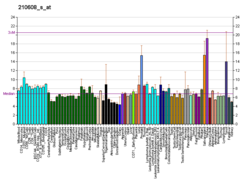Top Qs
Timeline
Chat
Perspective
FUT2
Protein and coding gene in humans From Wikipedia, the free encyclopedia
Remove ads
Galactoside 2-alpha-L-fucosyltransferase 2 is an enzyme that in humans is encoded by the FUT2 (fucosyltransferase 2) gene.[5][6]
FUT2 is a key enzyme that catalyzes the transfer of L-fucose from guanosine diphosphate-beta-L-fucose to the terminal galactose on both O- and N-linked glycans of cell surface glycoproteins and glycolipids. This enzymatic activity is essential for the synthesis of the H antigen, a precursor required for the formation of ABO blood group antigens,[7] and determines "secretor status"—the presence of blood group antigens in bodily fluids such as saliva. Beyond its role in blood group antigen synthesis, FUT2 influences cell-cell interactions, modulates the composition of the gut microbiome, and impacts susceptibility to infections and autoimmune diseases, highlighting its broad significance in human health and disease.
Approximately 20% of Caucasians are non-secretors due to the G428A (rs601338) and C571T (rs492602?) nonsense mutations in FUT2 and therefore have strong although not absolute protection from the norovirus GII.4.[citation needed]\
Remove ads
Role in secretor status
The FUT2 gene determines an individual's secretor status by encoding an enzyme responsible for the expression of histo-blood group antigens in bodily secretions. Approximately 70–80% of people are secretors, meaning they possess at least one functional FUT2 allele.[8] Those who are homozygous for a nonfunctional allele are termed non-secretors, which has important health implications.
Clinical significance
Summarize
Perspective
Non-secretors display altered susceptibility to both infectious and autoimmune diseases. While they exhibit increased resistance to certain viral pathogens like norovirus,[8] they are more prone to developing chronic inflammatory conditions such as Crohn's disease[9][10] and type 1 diabetes.[11]
Impact on the gut microbiome
Loss-of-function mutations in FUT2 dramatically alter the composition of the gut microbiome. Non-secretors have distinct microbial profiles compared to secretors, with studies reporting a reduction in Escherichia species and a rise in pro-inflammatory taxa.[12] Notably, non-secretors also exhibit increased levels of butyrate-producing bacteria, which are generally considered beneficial.
Consequences for microbial metabolism
Although FUT2 does not directly regulate microbial metabolism, its influence on microbial community structure can indirectly affect metabolite production. The enrichment of butyrate producers in non-secretors may represent a compensatory mechanism, but this benefit may be insufficient to counterbalance the elevated inflammatory potential of the overall microbiome. Thus, FUT2 loss-of-function variants may skew the microbiome toward a pro-inflammatory state, potentially exacerbating conditions such as inflammatory bowel disease (IBD) and masking the protective effects of beneficial metabolites like butyrate.
Remove ads
References
Further reading
Wikiwand - on
Seamless Wikipedia browsing. On steroids.
Remove ads






